
40 Years in America

|
|
40 Years in America |
|
The Providential Year of 1976
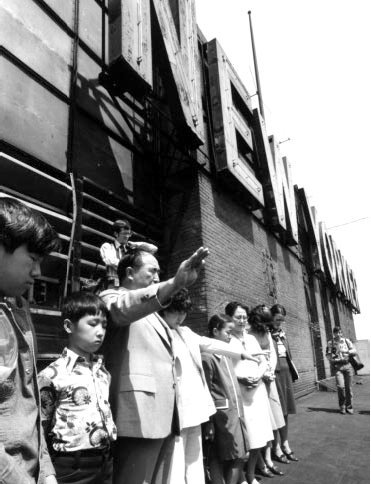
True Parents bless the New Yorker Hotel on May 21, 1976. Here they ask Godís blessings on the city.
The year 1976 was a year of extremes. On the one hand, it was remembered as the year in which opposition to the movement reached its peak. The kidnapping and deprogramming of members continued, there was a bombing of a church center in France, negative parent groups in the U.S. coalesced and were able to gain a public hearing before a powerful senator and numerous federal officials, and by the end of the year mainstream Jewish, Protestant and Catholic bodies turned on the Church. On the other hand, in spite of these obstacles, the movement carried out rallies on a huge scale at Yankee Stadium and Washington Monument; it continued to acquire major properties including the 40-story, 2,000 room New Yorker Hotel which overlooked Madison Square Garden in midtown Manhattan; and on December 31st, the movement began publication of a daily New York newspaper, The News World. According to Rev. Moon, his secret and the secret of the Unification Church "is that by being attacked and attacked we emerge victorious and prosperous." Although there were additional, unexpected peaks of persecution to come, this principle clearly was operative in 1976.
The two major events of the year were the great rallies at Yankee Stadium and Washington Monument. Together, they closed out the proclamation phase of Rev. Moonís ministry in America and provided the foundation for building a substantial movement worldwide. Rev. Moon understood that a failure to achieve success in these rallies would be a serious, even fatal blow to his ministry in America and the world. He also understood that the openness and expressions of goodwill with which the American public had greeted his earlier Day of Hope tours was quickly eroding. Hence, there was a sense of desperation in relation to the two campaigns. In one speech, Rev. Moon stated that the two rallies represented the "greatest battle" he had fought in his life. Convinced that success in America would have a dramatic impact on Europe and Asia, he instructed that "everything" be directed toward the goal of filling Yankee Stadium and the Washington Monument grounds.
The movement had eighteen months to prepare for Yankee Stadium. During that time, Rev. Moon inaugurated Barrytown Training in order to expand the churchís membership base as noted. However, he also utilized other means. In July 1975, he set up a 150-member American IOWC team in New York which differed from the Barrytown approach. Whereas the premise of Barrytown Training was that the movement could multiply its membership best through the efforts of solitary pioneers, the IOWC worked according to the previous team model. Secondly, whereas the Barrytown program emphasized obedience and the heavy consequences of failure, the IOWC position was that Rev. Moon had not demanded something from them but "inspired something within them." It also focused less heavily on negative outcomes. As the principal IOWC speaker, Neil Salonen, put it, "If we just push people down about how serious this time is, they are not going to be inspired to come." Thus, the IOWC was freer to adapt lighter measures. Its three constituent teams, for example, took the names Yan, Kee, and Stadium. Moreover, a highlight of its mini Day of Hope campaign at the New York Biltmore Hotel included leafleting done by members in skunk, kangaroo, teddy bear, rabbit (pink), squirrel and chipmunk costumes at Grand Central Station, Times Square and Rockefeller Center. One would be hard-pressed to imagine Barrytown pioneers in that garb.
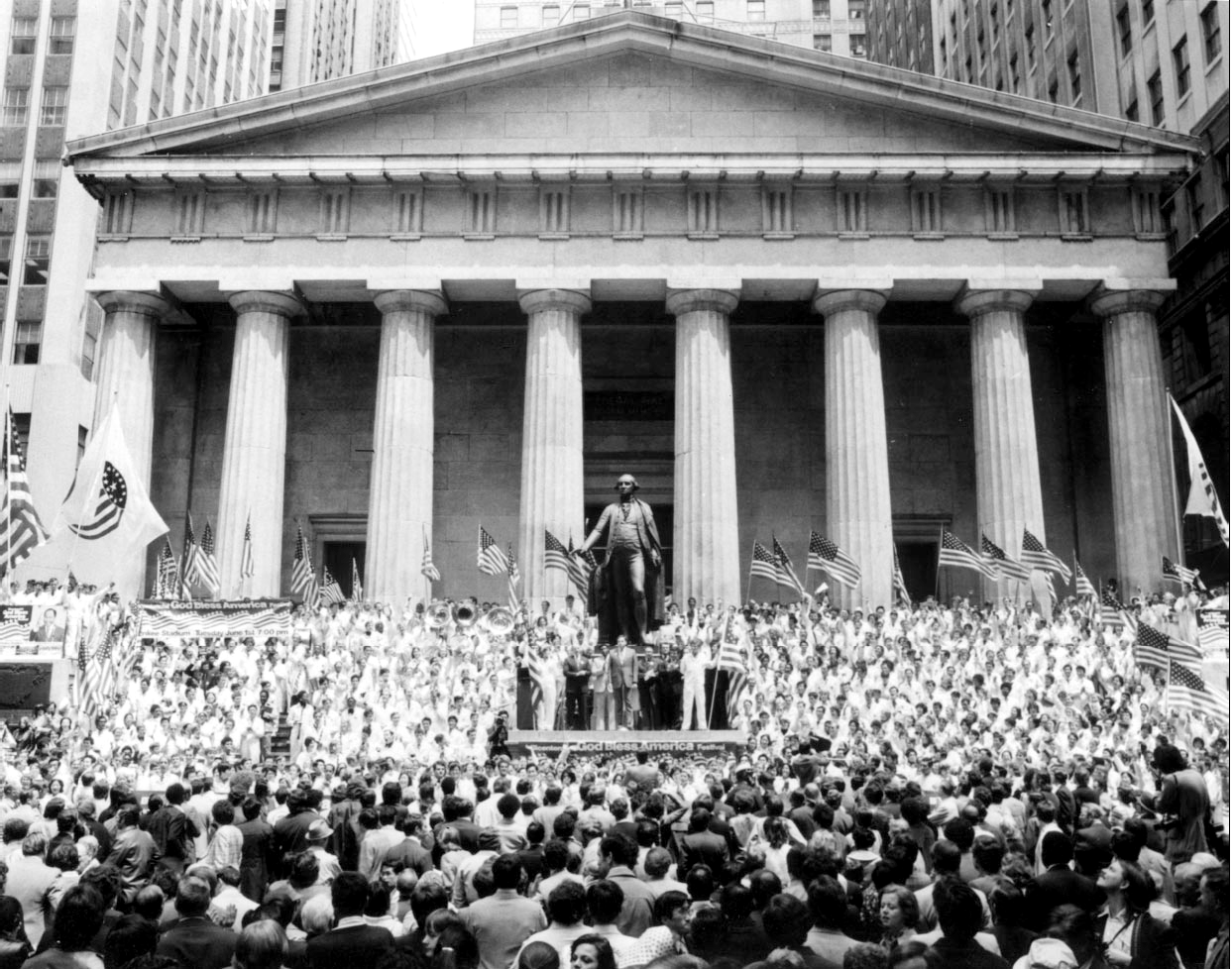
A pre-Yankee Stadium rally on Wall Street, New York, May 26, 1976
The American IOWC brought 2,000 guests to three nights of talks at the Biltmore Hotel. This inspired Rev. Moon who suggested that they undertake campaigns in New Jersey and Connecticut. In November 1975, still six months before the June 1st, 1976 rally, Rev. Moon revealed his plan to connect the Yankee Stadium and Washington Monument rallies to the American bicentennial.
The movementís "Bicentennial God Bless America Committee" was accepted as a member of the National Bicentennial Service Alliance on the basis that it planned at least one project of national scope and value. However, there also were several ominous developments. In January 1976, the Church felt compelled to publish "The Truth About Rev. Sun Myung Moon" ads in the New York Times and Washington Post to answer criticism. The kidnapping of members continued, and church leaders faced off against critics in the media. But by far the most ominous development was the coalescing of anti-Church associations, such as Citizens Engaged in Re-Uniting Families (CERF) and Citizens Engaged in Freeing Minds (CEFM). On February 18, 1976, these organizations sponsored "A Day of Affirmation and Protest" which included a two-hour presentation of grievances against the Church to U.S. Senator Robert Dole (R-Kansas) and representatives of seven U.S. government agencies.
The meeting before Robert Dole and various federal officials was said to be prompted by a petition signed by 14,000 Kansas residents. Senator Dole emphasized that it was "not a Congressional hearing" nor was it "any kind of investigation...a public speech-making forum...[or] a debate between opposing points of view." He noted that "no one is under oath" and nothing said or done was to be interpreted as "a prejudgment or stamp of approval by the legislative branch on anything." Representatives from the IRS, INS, Justice Department, HEW, Labor Department, U.S. Postal Service, and Federal Trade Commission were likewise noncommittal, noting that "questions could only be answered after a formal list of allegations in writing had been submitted, reviewed, and investigated." Still, the "Dole hearing" provided its critics with a well-publicized, credible forum to air their grievances before important national-level figures. More troubling from the Churchís point of view was the fact that its spokespersons were excluded from the proceedings. Senator Dole refused to meet with HSA President Neil Salonen before the meeting, though he did consent to meet with two members from Kansas who had escaped from deprogrammers. During the session, church members and their supporters could only maintain a vigil of protest at the back of the meeting room.
The "Dole hearing" precipitated a crisis for the movement. It was one thing to square off against media critics or against deprogrammers operating outside the law. It was quite another to witness oneís accusers receive a sympathetic hearing before a panel of government officials, and to be showcased with no opportunity for defense. The Church regarded this as persecution. Its immediate response was to gather parents to show support for the Church. The goal was to have 200 parents sign a telegram to Senator Dole protesting the way the Church was being treated and "to have thirty parents come to Washington to stand in support of their children." The Church was pleasantly surprised that over 800 parents sent telegrams and over 60 rallied to its support by traveling to Washington. Over the next several months, the Church sponsored nine local or regional Parentsí Conferences which led to the first National Parentsí Conference at the time of the Yankee Stadium Rally. Beyond this, ministers were contacted, "not in direct support of the Unification Church" but in support of the churchís rights, "because if they were threatened, the rights of all religions in this country could also be threatened." The Church hoped to have 40 ministers sign a telegram but discovered that more than 200 ministers responded.
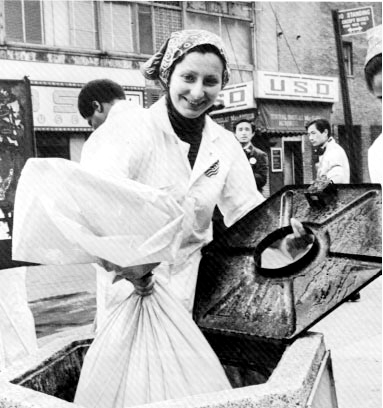
Members joined teams that fanned out across the city in a massive clean-up campaign
Internally, the Church was driven first to a fuller recognition that its battle was not only with flesh and blood but with principalities and powers. Rev. Moon, in particular, took this approach in his response to the crisis during the first three months of 1976. While visiting Korea for fifty days between January 26th and March 18th, he "set the condition for the unity of the spirit world" and returned only after the "barriers in the spirit world" had been broken and the Church could be confident of "marching forward" again. To solidify this resolve, Rev. Moon appointed Takeru Kamiyama as Yankee Stadium Campaign Director. In more welcoming times, he may have relied more on American or Western members for leadership. However, in this time of crisis, Rev. Moon turned to Mr. Kamiyama to lead the campaign much as he had turned to Mr. Sudo to direct the Churchís educational program. Mr. Kamiyama, who sold his blood to support church activities during the early days in Japan, led New York City witnessing efforts as well as Church fundraising nationwide. He could be counted on to spare no effort in meeting Rev. Moonís directive that the Church triple its membership in New York over the next forty days. From this point, he played a central role in preparations for Yankee Stadium.
Rev. Moon was essentially correct that the Church had gone over the "hill of persecution" during the first three months of 1976. After April, there were only minor flare-ups. In fact, the Church won supporters through its "America the Beautiful" project which began on May 3rd when "over 1,000 members took up...brooms and dustpans to clean Manhattan and the Bronx." Dressed in white jumpsuits with the God Bless America Festival logo silk-screened in red and blue on their back, members cleaned in their witnessing areas every day from 7-8:00 a.m. Mindful of "brainwashing" and "glassy-eyed" criticisms, Rev. Moon advised campaign workers not to "smile like a foolish person." The Churchís folk-rock band "Sunburst" provided free lunch-hour concerts, and even during the final push which brought in hundreds of more witnessers, massive ticket distribution, street rallies, and saturation promotion provoked minimal negative reaction. Church leaders were cautiously optimistic that the festival would attract a large overflow crowd.
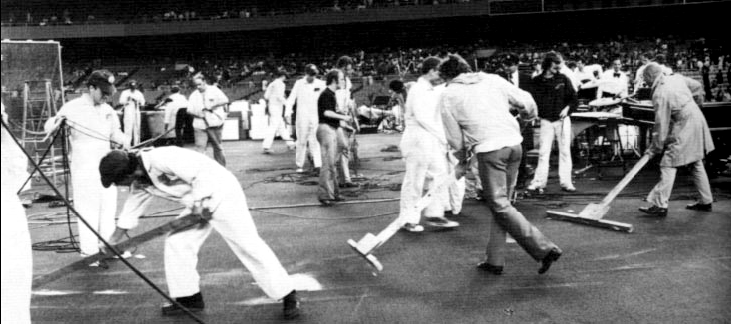
Mopping the stage after the skies opened in a massive storm over Yankee Stadium
This all changed the day of June 1st. There were two main problems. One was the weather. As reported in New Hope News, the Churchís official newspaper, "Huge gusts of wind, a precursor of the coming rains, foiled the inflation of a seventy-foot hot air balloon which was to have sailed above the stadium." The ripcord of the balloon next "gave way...causing it...[l]ike a deflating rubber balloon" to travel "erratically across the field...destroying many decorations." In particular, "Forty-foot Styrofoam letters spelling ĎGod Bless America Festivalí were uprooted from the ground and blown across the field...in pieces." A "driving thunderstorm then ripped across the Stadium at 5 oíclock, pounding the remainder of the decorations and soaking the stage." With all their music "lost under several inches of mud," the Go-World Brass Band performed from memory while the Churchís Technical Missionary Corps "used the music stands like snow shovels to sweep the water from the stageís carpet." Clumps of other members rose in their seats or danced on top of the Yankee Stadium dugouts, singing "You Are My Sunshine" until the storm subsided. Although the rain stopped prior to the start of the program, weather conditions undoubtedly kept many ticket-holders from attending or bottled them in jammed subway stations. The Stadium turnstile count was 40,000 with another 5,000 having come in before the count began, so that about 45,000 people came to the Festival.
Opposition protests outside and crowd-control inside were also problems. The New Yorker Hotel, newly designated as the churchís World Mission Center, and the Yankee Stadium rally functioned like magnets in attracting enemies of the church, rival religionists, and rowdies looking to create disturbances. The New York Times reported that there were 400 demonstrators and the Washington Post stated that "the festival attracted one of the largest assortment of protest groups since the end of the Vietnam War." The "religious smorgasbord" described by the Post included yellow-robed Hare Krishnas chanting and dancing, "hundreds of fundamentalist Christians" passing out tracts and preaching, Black Muslims hawking the Bilalian News, and a yarmulke- wearing groups searching for "Jewish kids caught up in...[the] movement." Ted Patrick and CERF members were prominent, as was the Communist Cadre division of Youth Against War and Fascism. Inside, according to one account, "groups of young, male toughs...roamed the stadium, fighting, robbing, setting off smoke bombs...and generally making a sour scene." The New York Daily News reported seven arrests, and the Poughkeepsie Journal noted that while Rev. Moon was warning that America would become a "living hell" if the will of God were forsaken, "bands of kids roamed the upper decks and corridors, destroying decorations, setting off smoke bombs and firecrackers, and starting fist fights." The Washington Post reported that "large numbers" walked out shortly after Rev. Moon began speaking, but the New York Times reported that "Most of the spectators...cheered, applauded, and waved little American flags." It all added up to an atmosphere that the Daily News described as "odd, disjointed, almost surrealistic."
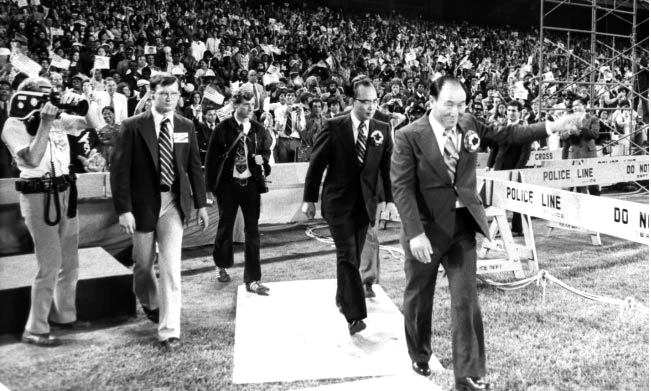
Rev. Moon takes the stage at Yankee Stadium.
At a celebration for all members at Belvedere on June 2nd, Rev. Moon posed the rhetorical question, "Did we win victory at Yankee Stadium?" He answered,
Iím sure that yesterday God shed invisible tears -- not because of the rain but because of your commitment, your loyalty, and your enthusiasm. You moved Godís heart yesterday....
For the last several months, we put out every ounce of energy for Yankee Stadium. At the last moment God gave us a big test.... But you sang, "You are my Sunshine," and Godís heart was melted.... Instead of being discouraged, you were in high spirits, protesting to God and trying to push away the rain...
Yesterday everyone tasted the bottom of Hell. Yesterday, as the wind blew and the rain poured down, the rain and your tears mingled on your faces. You tasted something miserable. At that moment, you would have done anything to make the rain stop. At that moment there was complete oneness and unification inside Yankee Stadium. That is the very thing God wanted to see....
I thanked God for His almighty wisdom. No one else could teach so many young people such a precious lesson in twenty minutes. That is the place where Godís heart was moving. There was no other way to teach the heart of God to the young people of America. For the sake of God you were praying and singing for the rain to stop. In that moment you tasted the heart of God in His anxiety to bring His Kingdom here. This is a great gift.... We must thank God for this precious gift for the sake of our education.... Today is indeed a victory celebration and day of thanksgiving for the blessing of God.
Download entire page and pages related to it in ZIP format
Table of Contents
Information
Tparents Home